Costa Rica 15-22 December 2009
Central American border crossings are notorious for the amount of bureaucracy (necessary and imaginary) involved. For some reason all border officials are obsessed with the need for copies of everything - you need photocopies of your passport, temporary importation document for the bike, international driving licence and vehicle registration document - sometimes you need two copies of these but you don't find this out until you've got to the front of the queue and presented one photocopy...
For Costa Rica, to get our passports stamped, generate a one-page document for the bikes, plus buy the compulsory 3rd party vehicle insurance ($15) took two and a half hours. I managed to get both passports stamped while Pat watched the bikes but you have to do the bike paperwork individually.
This involves queuing with all the lorry drivers in my case I was behind a Czech lorry driver who couldn't read the Spanish form he had to fill in. The documentation process for the bikes is complicated by the fact that all the customs guys and girls we get have never seen one of our reg docs before. Then when you think you're done and you've put your documents away and ride off, there is a check point where you have to show everything again and they write things on a sheet of paper.

Costa Rican Topes ... the first of thousands of horrid speed restrictors in Central America
Having left Panama late because of the bank problem, we were in danger of running out of daylight. Once over the border, we headed along the coast road towards a small place called Uvita, pursued by a gigantic lorry. Speed limit was 80kph and we were doing 90 with him in hot pursuit but it was a glorious evening with a wonderful sunset and a good road so we went for it and of course it went dark as we arrived.
The hostel we stayed in was up a road that was being resurfaced. The surface was mud. Sticky, slippery mud and it was raining. Pat is much braver than me and also has much longer legs so I wimped out and let her slither into the hostel for both of us.... Zero street cred for me. Many brownie points for Pat.
The next morning was even wetter and a lorry slid off the road into the ditch in front of us. However Pat brilliantly slithered both bikes back down to safety, and got a round of applause from the ladies outside the local shop when she nearly lost it.
We then spent a fascinating couple of nights at Finca Tinamaste, courtesy of Simone and Francisco and their three children, whom we'd met in Panama. The Finca is set against a cliff and surrounded by forest full of howler monkeys whose booming calls reverberate around the valley from about 4am onwards.
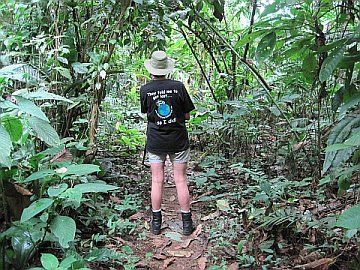
Pat goes for a walk
Several families live in this Protestant evangelical mission that reaches out to indigenous tribes in remote areas, offering training courses in agriculture, carpentery, engineering (Pat says the workshops are impressively equipped), maintenance and bible classes to young men from the tribal villages. Skilled volunteers from Switzerland and Germany come for a year to support the families who live there and the ones we spoke to were having a great time. It's an idyllic environment for children to grow up in they run free in a way unimaginable in Europe today. Our friends are going back to Switzerland shortly after twelve years and the 15 year old daughter is quite apprehensive she's never been on a train she told us.
Jesus es el Senor de este Valle was on a huge billboard as we came down off the Cerro de la Muerte (Hill of Death). This overwhelming faith in the power of the Lord would appear to absolve Costa Ricans of any responsibility for their own actions on the roads. It's the worst driving we've seen yet. The Cerro de la Muerte is over 3000 metres and is so called because of the numbers of people who died of cold and exposure in the old days as they made their way to trade their goods in the capital San Jose.
The road is now paved but still very winding and quite narrow, and when we stopped for a snack in a rare safe place, we watched transfixed as a fully-laden bus lumbered up the other side of the double yellow line, past a huge container lorry, towards us. Just behind us was a blind bend....
On the other side I picked up a 3-inch nail in my back tyre. Pat had to demolish her panniers to get at the tent poles to prop the bike up so she could get the back wheel out, and find the tyre levers to get the inner tube out,. 90 minutes later I was back on the road!
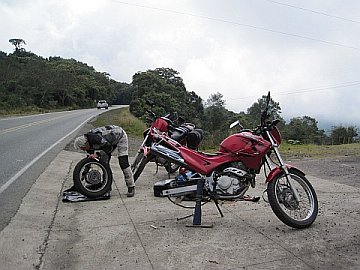
Puncture!
My contribution was to make encouraging noises, ward off the mangiest dog I have ever seen from weeing on our piles of luggage and help with the pumping up of the new inner tube with our small hand pump. I warmed up nicely during this exercise. Pat wants to know why I only get punctures over 3000 metres..... my last one was on the Peruvian altiplano in 2006.
A one-night pit stop in San Jose was enough and we set off in horrendous traffic the next morning. Got up into the hills and the cloud (or was it fog?) and drizzle descended. Suddenly the road was blocked as far as we could see, so we did the usual and overtook everything till we got to the cause. A massive artic loaded with oranges had side-swiped a 4x4 on a bend and knocked it off the road, fortunately against the hill rather than over the mountain edge.
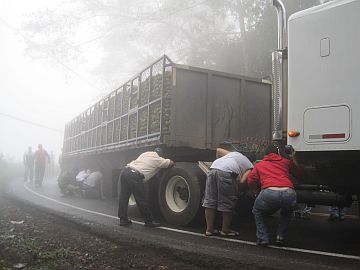
Rubbernecking at the crash scene
Dozens of trapped drivers gazed ghoulishly, took photos and films and generally got in the way as the bomberos (firecrew) cut the family out of their car. The latter were apparently ok fortunately. Eventually the police let the motor bikes through, but Pat had to negotiate an impossible 90-degree turn on the churned up road edge between the rescue vehicles. A squat but immensely strong man picked her bike up by its rack and swung it round (complete with Pat and all the luggage aboard) and then repeated the process with my bike.
We do not ride at night. It's dangerous bandits (maybe), unlit animals and people and vehicles, and you can't see the rocks, potholes or road edges when they disappear or road signs on the rare occasions there are any. Tonight we had an hour and a half ride in the dark off that mountain which was a bit hairy. Naturally it was also raining. That day's three-hour journey took eight hours.
Arrival finally into Fortuna and the whole town is in a state of excitement it's the monthly Tapa de Caballo - dressage competition and all the cowboys from miles around are parading in their finery. Tiny children sit up there with their proud fathers who put the horses through their paces, effortlessly controlling the snorting animals with an occasional whip, but mostly with invisible signals all this to the deafening accompaniment of stirring music from a distorted amplifier.
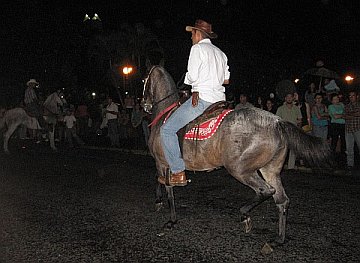
Tap Dancing for Horses
Add to this mix the flash from cameras and the inevitable bombas (firecrackers) that come with any Central American celebration and ignore the rain that continues to fall.
And fall.... next day we can't see the famous Volcan Arenal we'd come to visit and the town is full of bedraggled tourists mooching about unwilling to pay the high tour prices with the likelihood of not seeing anything...ourselves included. The other volcanos around San Jose had been similarly shrouded so this was all rather disappointing. But the horse tap-dancing competition was a definite highlight.
And fall.... we decided to give up on Costa Rica and rode towards the border another day of continual rain and heavily populated so it's quite difficult to find a bush to pee behind. All the potholes in a 20km stretch of gravel road were brimming over with water so you have no idea how deep they are....
It's a shame the weather was so bad as Costa Rica is famed for its wildlife and stunning volcanoes. Its tourism infrastructure stole a march on the rest of Central America as it's been peaceful and therefore more prosperous than other countries. It was lucky not to have the mineral wealth the Spanish sought, so escaped the worst excesses of the Conquest. Standards of living are the highest in Central America and it's been a democracy for 130 years. Large numbers of foreigners have bought property here, but they've taken a real pasting in this recession. Estate agent windows are full of properties headed firesale or foreclosure.
Our departure from Costa Rica coincided with Christmas week and 25,000 Nicaraguans going home for the holidays, so this border crossing took five hours......
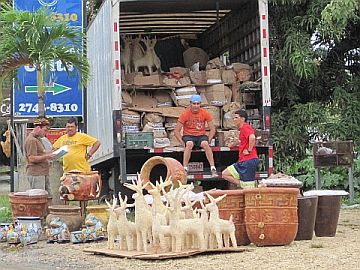
Christmas reindeer for sale in Costa Rica
